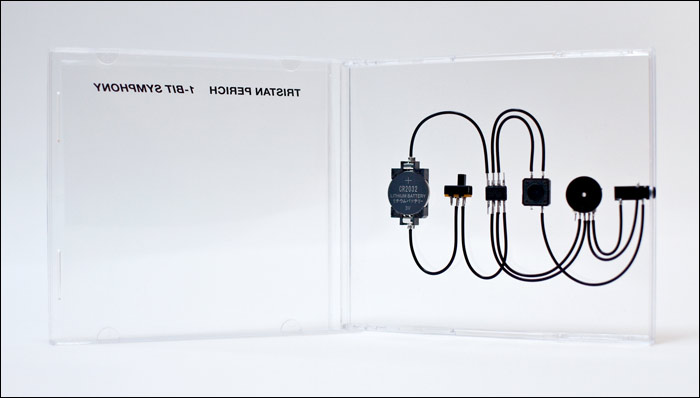
1-Bit Symphony
Cantaloupe
As much as musicians may like to think of themselves as artists, there’s a reason it’s called the music industry. For however peripheral an artist (there’s that word again) may be and however artistic their chosen output, at some point there’s going to be some commerce involved, whether it’s big label contracts or just trying to sell your work at shows or in the subway. Don’t get me wrong, I’m all for artistic endeavor and can certainly appreciate a good slap in the face of commercialism, but even a Radiohead or Diamanda Galas is going to have to deal with the real world of the industry at some point. There’s nothing wrong with that, but when money is involved nothing is ever just art for art’s sake.
In that sense, maybe Tristan Perich’s art is just as susceptible to green tinting, but I don’t think so. What he does isn’t even really about music so much, even though his latest project is being “released” by a record label. While he studied music in college, he also went to school for math, computer science and electronic art, and the pieces he’s created have seemingly involved all four disciplines to varying degrees. He's created pen and paper drawings using a machine (Machine Drawings) and used binary electrical pulses to create cathode ray television images.
Still, music has often played a central role in his projects. He is a member of Loud Objects, a trio that actually performs live, though what the audience witnesses is more like a welding class than a concert, with the group soldering their own noise-making circuits from scratch. He was recently commissioned to create a microtonal audio installation using 1,500 speakers for Rhizome at the New Museum in New York. And 1-Bit Symphony is meant to be a sequel of sorts to a piece he did in 2006, 1-Bit Music, which was an electronic circuit inside a jewel case that played 40 minutes of electronic music. 1-Bit Symphony is a similar construction, with the listener plugging into a headphone jack to hear the five movements of this piece created by converting electrical pulses into code which in turn is deciphered into sound.
Merely as a physical object, there is something bewitching about 1-Bit Symphony, and I’m reminded of the Buddha Box a bit (no pun intended). Comprised of just six components—a battery, an on/off switch, the microchip, a fast forward button, a volume knob, and an audio jack—the simplicity of Perich’s design holds an aesthetic value. But also conceptually, the piece is at once wonderfully modern and pleasingly primitive. That such basic circuitry is able to create music seems somehow bewildering and gratifying in contrast to today’s camera-phone-stereo gizmos.
That the music itself is of little consequence shouldn’t come as any surprise (which is why it’s not being reviewed as an album), though it’s probably more composed than one might expect. While tonally a little archaic, the blips and beeps are arranged in a threaded criss-cross that reveals Perich’s mastery of his chosen form. Truthfully, I’ve heard synth acts sound worse, and once one becomes accustomed to the tonal flux, there’s much to be appreciated. Nonetheless, the audio component is less about sound and more about technique, with the artist revealing how very little is needed to create music. Elegance has always been a concern of Perich’s and here he reveals just how refined his work can be.
Stephen Slaybaugh
A Live Evening with MGMT
The World Cup Top 10
Five Hundred 45s
Jello Biafra and the Guantanamo School of Medicine and Chrome Cranks Live Reviews
David Cross, Bigger and Blackerer
Rock 'n' Roll High School
Beach House Live Review
I Need That Record!
The Specials Live Review
The Antlers Live Review
Girls and the Wedding Present Live Reviews
The Big Pink and A Place to Bury Strangers Live Review
Jello Biafra and the Guantanamo School of Medicine and Joanna Newsom Live Reviews
SXSW 2010 Recap
